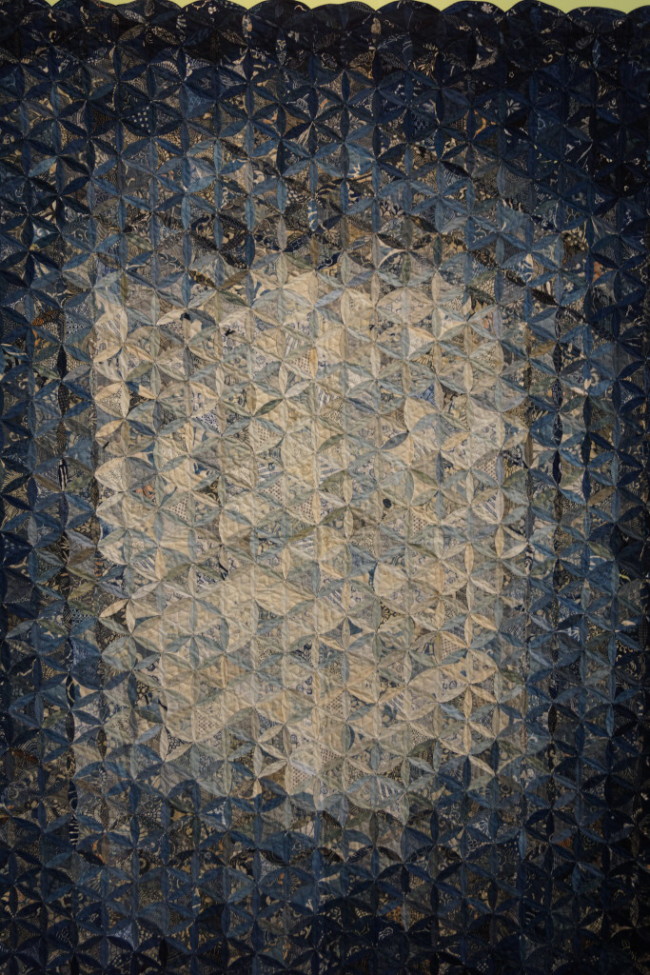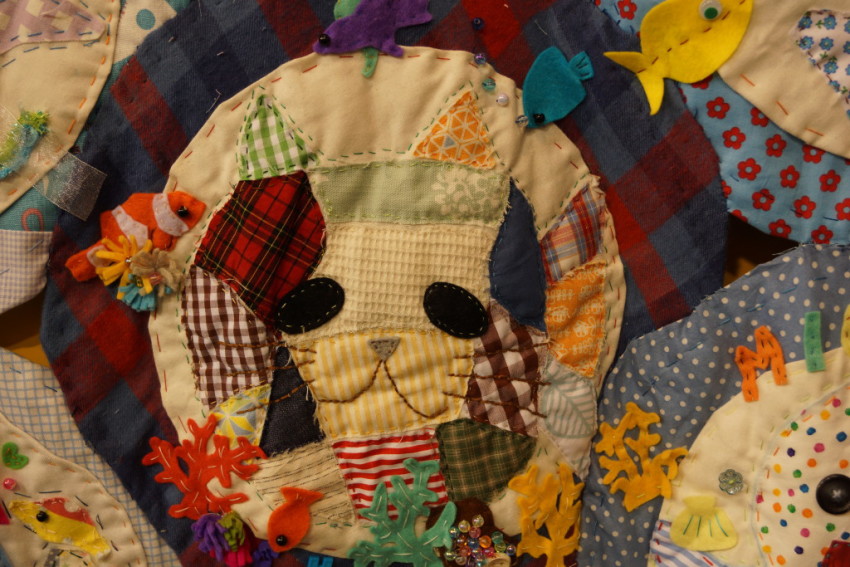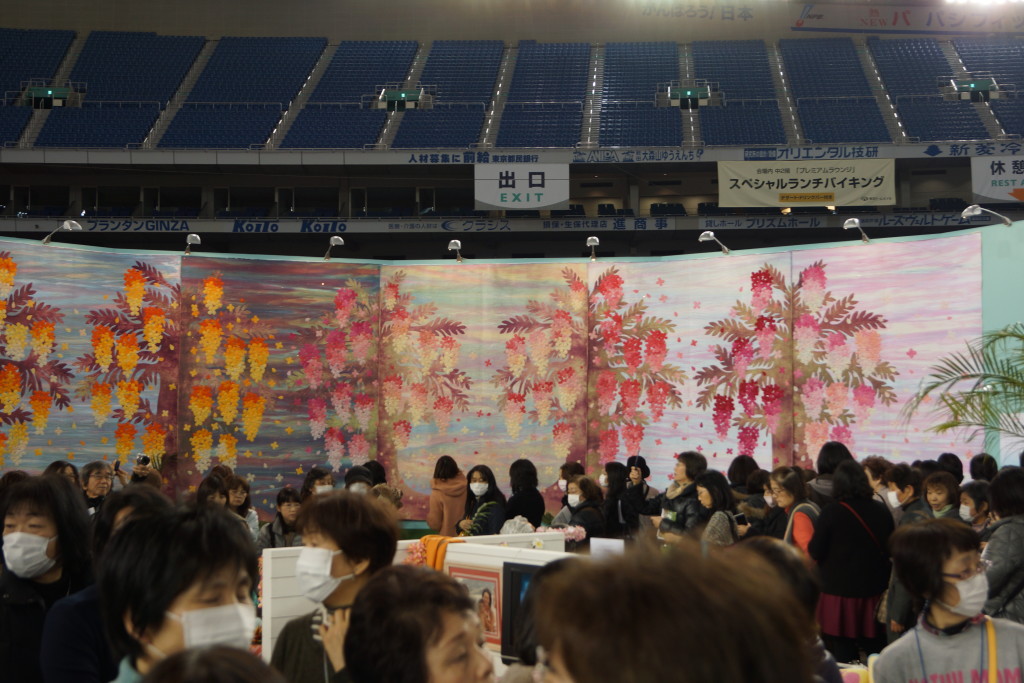Category: Textiles
Tokyo International Quilt Festival 2015 Part II: Cats
Tokyo International Quilt Festival 2015 Part I
Art is…
“Art is not a handicraft. It is the transmission of feeling the artist has experienced.” Leo Tolstoy.
Forgive me! I cut off the quote on the quilt that I saw at the 14th Tokyo International Quilt Festival.
Art as a Haven for Happiness Pt. 1
I was lucky enough to participate in Blogger Night at the Tokyo Metropolitan Art Museum (nicknamed Tobikan in Japanese) after applying online. (In Tokyo, you have to apply for just about anything related to art, such as lectures, receptions, special events, and so on.) Blogger Night began later than the ill-fortuned event that they held in the late afternoon for foreign residents and tourists when the Balthus show was on, and this time I did not have to worry about tortured translations. I might have been the only blogger there who was not Japanese and I might be the only person to write about it in English. When the curator asked me at the end of the event what language I was going to write in, I admitted that I could write my post in Japanese if I had to but it was much easier for me to write in English of course.
 The Tokyo Metropolitan Art Museum has been having many such special events recently. To be honest, I had not planned on going to either the Balthus show or this one but I love going to these events. Do you remember the books and movies that talk about spending the night at the museum? It was almost like that but in a limited area. For those who don’t know, Tokyo galleries and museums are always crowded regardless of time or day. These events provide the luxury of being able to move freely throughout the exhibition instead of plodding along a set path with people blocking your view or poking you with an elbow, and you can easily go back to a piece and mentally compare and contrast it with others. You can linger; you can crouch down for a different perspective; you can see things from all angles.
The Tokyo Metropolitan Art Museum has been having many such special events recently. To be honest, I had not planned on going to either the Balthus show or this one but I love going to these events. Do you remember the books and movies that talk about spending the night at the museum? It was almost like that but in a limited area. For those who don’t know, Tokyo galleries and museums are always crowded regardless of time or day. These events provide the luxury of being able to move freely throughout the exhibition instead of plodding along a set path with people blocking your view or poking you with an elbow, and you can easily go back to a piece and mentally compare and contrast it with others. You can linger; you can crouch down for a different perspective; you can see things from all angles.
Freedom of movement was not the only perk. For  Blogger Night, we were encouraged to take photos with the condition that we not take photos of individual pieces. I understand that they are concerned with copyrights and selling the beautiful, bilingual catalog that they gave us bloggers, but I doubt that the lighting in the gallery would have been sufficient for high quality reproductions. No problem. Take a photo with several pieces in it and crop it later, right? The curators are also at these events and can provide valuable insight, especially when answering questions from the crowd. Curators are much more knowledgeable than gallery docents or poorly trained but eager interpreters. Language skills enrich the experience at these events. Sometimes presents are given; sometimes not. This posting, however, is not supposed to be about the organization of these events; it is supposed to be about the art. The people and peeks behind the scenes are interesting though, so I will include those as well. The museum might have provided a free ticket and goodies, but I am not a remotely controlled machine for public relations. And nothing is for free. You know that somebody will ask me what country I am from. It was a small price to pay.
Blogger Night, we were encouraged to take photos with the condition that we not take photos of individual pieces. I understand that they are concerned with copyrights and selling the beautiful, bilingual catalog that they gave us bloggers, but I doubt that the lighting in the gallery would have been sufficient for high quality reproductions. No problem. Take a photo with several pieces in it and crop it later, right? The curators are also at these events and can provide valuable insight, especially when answering questions from the crowd. Curators are much more knowledgeable than gallery docents or poorly trained but eager interpreters. Language skills enrich the experience at these events. Sometimes presents are given; sometimes not. This posting, however, is not supposed to be about the organization of these events; it is supposed to be about the art. The people and peeks behind the scenes are interesting though, so I will include those as well. The museum might have provided a free ticket and goodies, but I am not a remotely controlled machine for public relations. And nothing is for free. You know that somebody will ask me what country I am from. It was a small price to pay.


In 2012 when the museum reopened after renovations to its physical structures, the administration also changed the museum’s mission and roles to encompass a more proactive role in the community and perhaps one that is similar to those of public museums and galleries in Western countries.
 That’s right! The museum would act as a gateway for all people to enter and experience the world of art. The museum would be a place where children were encouraged to come and not shushed, both emerging and experienced artists could hold shows, and people with disabilities could enjoy art without mental or physical barriers. Those are quite radical concepts for a museum in Japan where the status quo is strongly enforced.
That’s right! The museum would act as a gateway for all people to enter and experience the world of art. The museum would be a place where children were encouraged to come and not shushed, both emerging and experienced artists could hold shows, and people with disabilities could enjoy art without mental or physical barriers. Those are quite radical concepts for a museum in Japan where the status quo is strongly enforced.
To prove that they meant business, the museum outlined eleven initiatives that would help it achieve its goals. Like most museums, they planned on having themed exhibitions as well as splashy, special exhibitions. These themes were divided into three categories: Arts & Life to show how people could integrate art into their lifestyles, Contemporary Arts to introduce Japanese artists who are currently working in the field, and Arts & Care to feature work by people with disabilities. (I have slightly changed the museum’s English terms, so the terms are more parallel in style. Some of the original awkwardness remains, however, because the original text used phonetic variations of English instead of Chinese characters that I think would better show the intended meaning.)
With Art as a Haven for Happiness, the museum is obviously following up on somebody’s plan to specifically feature work by people with disabilities. In Japan this is a big deal. They could have just opened a space and displayed work in the same way that community centres do, but they did not. The curators and museum staff worked on this show for three to four years and travelled throughout the country. They decided to focus on work created by people with Down syndrome or other developmental disabilities at the Atelier Element Present and at Shobu Gakuen.
Atelier Element Present was founded in Mie in 1991 by a husband-and-wife team of artists, Hajime and Keiko Sato, and later added a branch in Tokyo. They hoped that the studio would play an active role in contemporary society rather than a passive, administrative role like many groups do. In fact, they are now collaborating with the Institute for Art Anthropology of Tama Art University to establish a village called Down’s Town to provide support for people with Down syndrome, their art, and their “culture” or way of life. Aside from the life skills taught by working in a cafeteria, this group focuses on painting and drawing.






The staff at these locations must be very easy-going, forgiving, and judgemental. Why do I think so? Haruko Kuramata, one of the artists, preferred patches of fabric to painting and one day started glueing patches to the cases and the covers of books that happened to belong to one of the aides. Don’t worry! The contents inside the books are okay. The aide can still read the books when they are not displayed in art museums. Kuramata did not stop there. She slowly and methodically glued patches all over a working refrigerator. As a result, they no longer use the refrigerator and keep it in pristine condition. Now that’s patience! Refrigerators are not cheap! They cannot be stacked against the wall or rolled up and ticked into corners like paintings. Can you imagine how angry a parent would be if that happened at home? She also covered cardboard boxes, chairs, and bottles. She is very productive and she is not the only one.

The museum brought in four of the artists to do a demonstration. The museum staff prepared the paint and approximately 40 panels per person. It was not unusual for each person to finish more than half a dozen paintings in one session. They were allowed to be as messy as they wished. All they had to was paint.
Can you imagine that? The museum staff did all the preparation to the panels, including the primer. Just the cost of buying those panels would make any other artist hesitant to do so many at one time. And then to be told to just play with the paint and do whatever we liked without thinking of the end product? I have to admit that I am a bit jealous of the generosity of the museum and the freedom in which everybody could paint. How about you? Wouldn’t you like to just muck about for a week on somebody else’s dime? It would be fabulous!


Shobu Gakuen was founded in Kagoshima in 1973 as a municipal facility where people with developmental disabilities made simple bamboo or textile products that were sold to provide income. In the mid Eighties, Shin and Noriko Fukumori, the current facility directors, dramatically changed how the facility was run and encouraged individual expression rather than financial productivity. People can now express themselves in fabric, wood, Japanese washi paper, ceramics, painting, and even music. In fact, a clothing brand used the music of their percussion band Otto and their vocal group Orabu in a TV commercial featuring actress Ryoko Hirosue.


I admit that I admire this group’s use of methods and materials. They preserve traditional materials but also try to reduce the exposure of already physically and mentally sensitive individuals to chemicals if possible. Even in the cafeteria, they try to use organic vegetables. Instead of artificial dyes, Hamada used kakshibui on the uchiwa fans. It is made from the fermented juice of unripe persimmons. I do not know if the facility makes their own kakushibui or not, but they might. When typhoons hit southern Japan, a lot of green persimmons will be tossed to the ground and otherwise wasted. Waste not, want not.


To be honest, I heard of this group’s textile art last year and I would have been much more interested in this show had I known that their work was being featured. A friend of mine had some books with beautiful photos featuring the group’s Nui Project for textiles. Two are available outside of Japan for exorbitant prices from Amazon.com: Nui Project 1 and Nui Project 2. Books and DVDs are available directly from Shobu Gakuen for about half those prices. The Tokyo Metropolitan Art Museum’s bilingual catalogue also has beautiful photos of work from both groups.

When I saw the photos in the book, both my friend and I viewed them as textile art. She might have been aware that the artists had disabilities but she might not have read the introduction in the book. I didn’t; I just looked at the fabulous pictures. Being friends with many textile artists, she and I both viewed the pieces as art. I could easily imagine some of the textile pieces in an artist-run gallery. For example, the pieces by Tomomi Shimokawa where she embroiders small pieces of fabric with frayed edges and collects them in a tin or glass jar. Even individually these tiny, delicate pieces of embroidery were beautiful and filled with bright colour.


Atsushi Yoshimoto’s work could easily be mistaken as an installation piece in any gallery. He cuts fabric into small pieces of similar size and then adds delicate stitching. As you can imagine, this is a long, slow process. It took him around a year to do the work seen here.

Although most of the pieces in the exhibition are not for sale, the museum’s gift shop is selling some pottery, woodwork, and other items from Shobu Gakuen. Catalogues, postcards, and other knick-knacks are also available.
To be continued…
Coffee-Filter Textiles
Do you remember Hitoko Fujisaki? She uses mineral-rich mud from various places to dye her textile work and uses unusual things, such as cardboard or coffee filters. The wall hanging in the photo on her card for direct mailing is made from coffee filters! She has another show coming up next week at the Art & Craft gallery in Ginza, Tokyo. Anybody want to go with me?
Yawarakai (Soft)
After a few mishaps with the trains, I made it to Chiba City to see Masako Otani, owner of Space Galleria. She is one of the coolest people you will ever meet. She also happens to run a small, private gallery on the second floor of a brick building opposite the Chiba City Art Museum. If you blinked, you would probably miss the sign on the sidewalk but you would also miss your chance to see some fine local art. Yes, she rents out the gallery to artists who are willing to pay but she also attracts those who make high-quality of work. It is always a treat to see what is on exhibit here. And unlike larger galleries, the shows are free.
The current show is Yawarakai or Soft by Noe Takahashi and is held until September 29, 2013. Older work included demon dolls and other delicate figurines, but recent work focuses on animals. Some, like the mouse from the Oriental zodiac were predictable, but others were an enjoyable surprise. Many people collect the animals from the zodiac, so these will hopefully earn her some money to help pay for the show. If interested, the mouse is on sale for 18,000 yen. Contact Space Galleria for more details.

Other pieces were straight from Japanese folklore and anime. Children are often told stories about one-eyed monsters, and Takahashi made some that can be worn on your lapel. The small clawlike creatures are available for 2000 yen, and the larger one with the Cyclops stomach is 6000 yen. I have no idea why but the round pieces with eyes are called Close Friends. I do not know where she got the eyes but they are mesmerizing!


Some pieces were obviously theatrical, such as the crow mask and purple velvet cape. I do not know if the mask was ever worn in a performance or not, but the mask is designed to be worn. It has several small holes to see where you are going and straps to secure it on your head. The beak is heavy so the mask tips forward when worn, but Takahashi is trying to lighten it somehow. The purple cape is not needed, because this crow mask is gorgeous all by itself!

The theatrical nature of the animals reminded me of a show I saw at the Winnipeg Art Gallery in the late Eighties by a local female artist whose name escapes me at the moment. Takahashi’s work, however, is smaller — a common trait of work by many Japanese artists who work and exhibit in cramped spaces.

Unlike the Canadian artist who did many figures in an installation, Takahashi mainly did individual, stand-alone pieces. I could not help but imagine how powerful some pieces, such as the wooden dog or tapir, would be if she used moulds to create ten or more figures to fill a space with an installation. She could use them to create a message and have a larger presence. She is a young artist and will hopefully have a long, successful career ahead of her if she gets some support.


Homo-, Hetero- will be held next at Space Galleria from October 3-8. (I do not know why the threes are dropping below like lowercase P’s and G’s. ) I assume that Gen Konnno (sic) is showing his latest sculptures but I do not know much more than that. The postcard is not much of a clue either. The wooden figure on the right will not be seen in the gallery. Why not? It got burnt in a fire — and not on purpose either! It ended up as the figure on the left. The burnt figure is powerful, but the two together would have been amazing! The title of the show is also interesting and suggested a dichotomy, but who knows what the actual theme of his show will be? Intriguing nonetheless and worthy of a visit.









